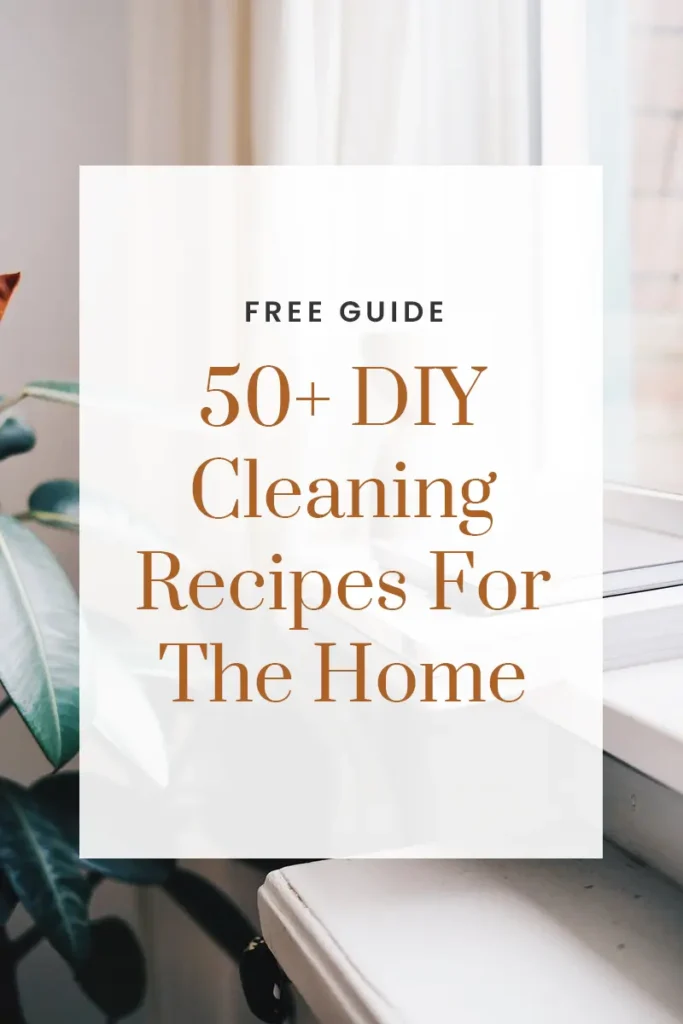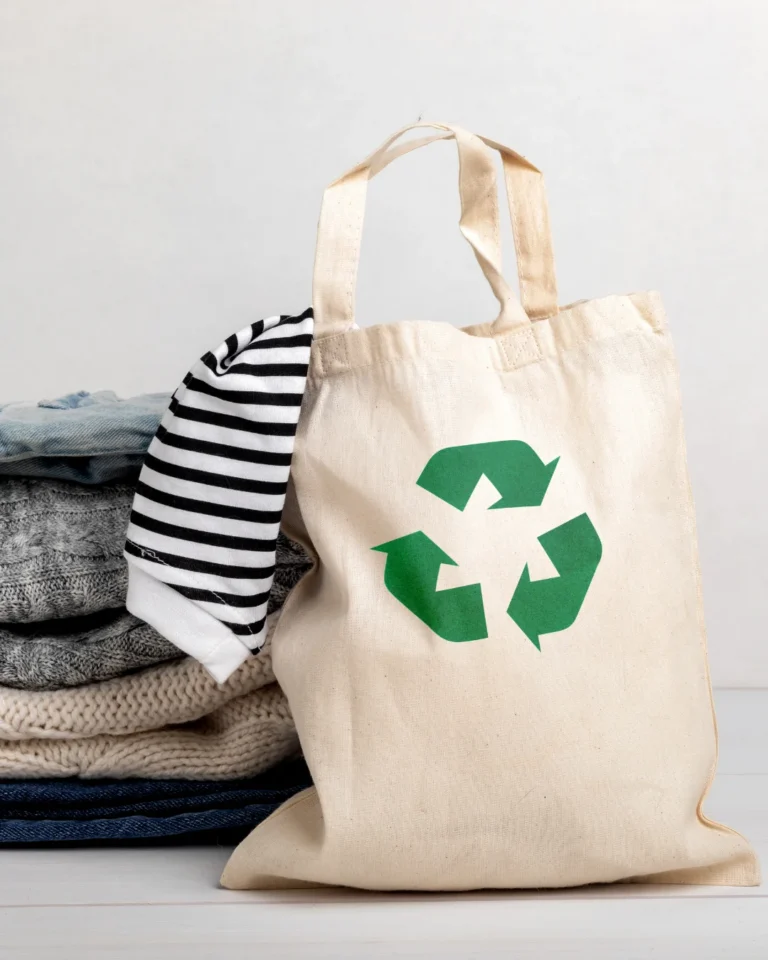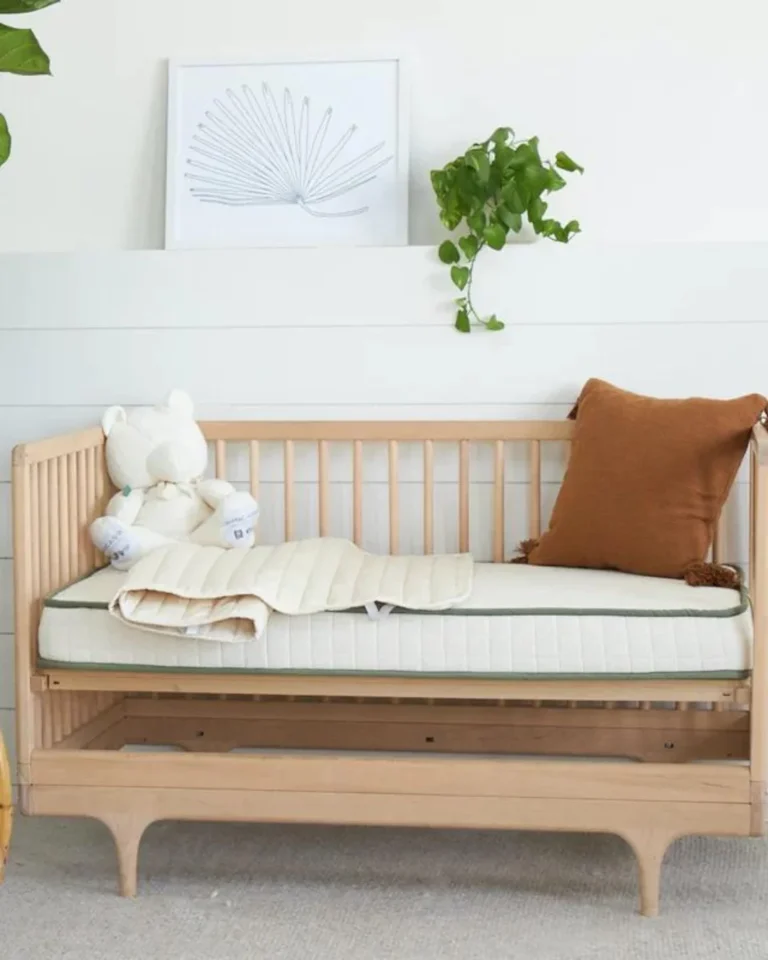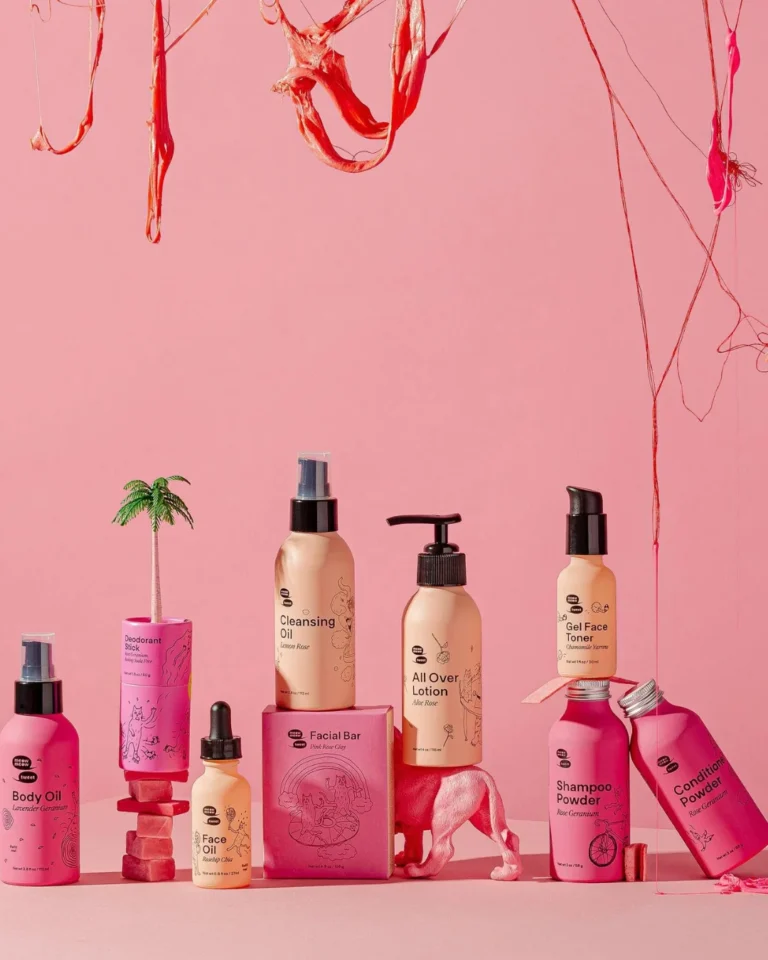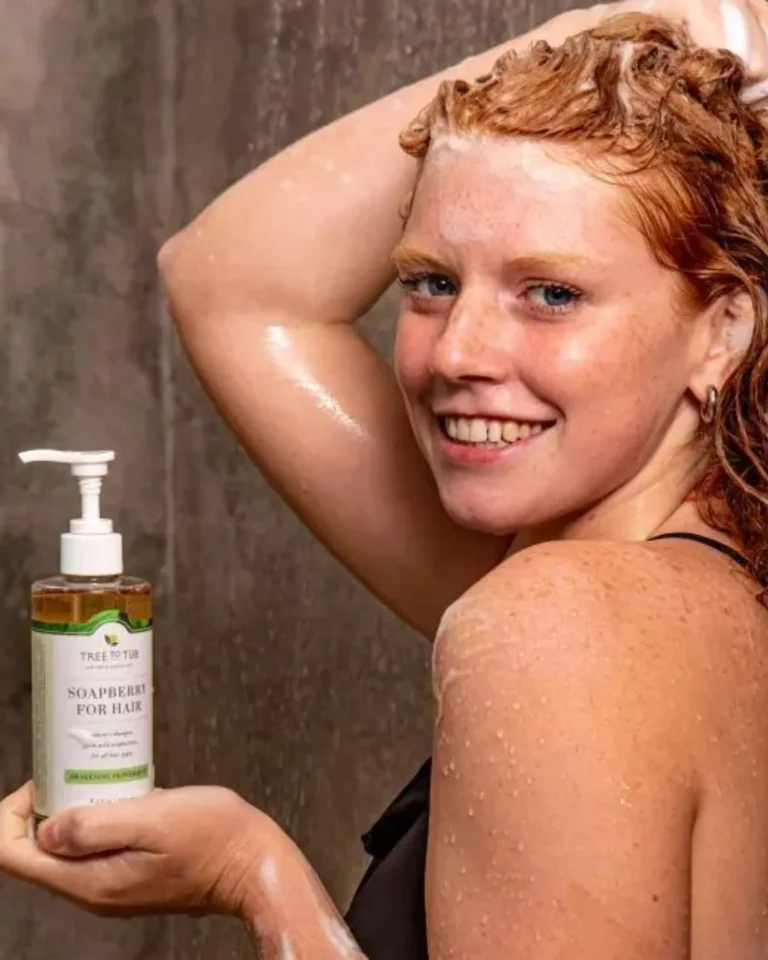SKL is reader supported. When you buy through links on our site, we may earn affiliate commission. Learn more here.
In this beginner guide to non-toxic living, I’ll share my tried and true, actionable tips on how to transition to a toxin-free lifestyle—without turning your world upside down.
I’ll take you room by room, sharing the best non-toxic swaps for each space, from the laundry room to your baby’s nursery.
You see, health-conscious living doesn’t have to be complicated, intimidating, or expensive, and my goal is to break it down for you in a way that’s relatable and achievable, no matter where you are on your journey.
Let’s get started on creating a healthy home environment for you and your loved ones.
SKL Beginner’s Guide to Non-Toxic Living…
It’s no secret that we’re literally surrounded by chemicals—many of which we can’t even pronounce, let alone understand what they do to our bodies.
When I first started learning about chemical-free living, I thought I’d have to immediately replace everything from my laundry detergent to my mascara—and do it on a budget. It felt impossible.
The truth is, you don’t need to do it all at once. The best approach is to start with small changes that have a big impact.
Focus on the areas where you and your family are exposed the most: personal care products, cleaning supplies, and the food you eat. From there, you can gradually swap out the rest.
“Non-toxic living is super expensive.” – I hear you mumble in frustration
This one hits close to home because, let’s be real, some non-toxic products can be pricey. But here’s the thing: not everything non-toxic has to cost an arm and a leg.
In fact, many of the changes I made early on—like switching to DIY cleaning products made from vinegar and baking soda—actually saved me money.
Sure, some organic or eco-friendly brands can seem expensive compared to conventional products, but the key is to be a smart shopper.
There’s also a common misconception that “natural” or “non-toxic” products don’t work as well as their chemical-laden counterparts.
I used to think that if I switched to natural cleaning products, my house wouldn’t feel really clean, or that using an all-natural deodorant meant I’d be giving up my social life because of, well, you know.
But honestly, I’ve been pleasantly surprised by how effective non-toxic products can be when you find the right ones.
But before we jump into the best non-toxic living tips for beginners, let’s first understand what chemical-free living really is.
What is non-toxic living?
Non-toxic living is exactly what it sounds like—creating a lifestyle that minimizes your exposure to harmful chemicals and toxins in your everyday environment.
It’s about being mindful of the products you use, the food you eat, and the materials you surround yourself with, making sure they’re as safe and natural as possible.
This doesn’t mean you have to live in a cabin in the woods, making your own soap (unless you want to, in which case, go you!). It’s more about making small, intentional choices to reduce the chemical load in your life.
Toxins are chemicals that can harm your health when you’re exposed to them over time. They can come from just about anywhere—personal care products, cleaning supplies, cookware, clothing, furniture, and even the air we breathe.
The scary part is, that many everyday items we don’t think twice about contain hidden toxins that have been linked to a variety of health problems, from skin irritation and allergies to more serious issues like hormone disruption, fertility problems, and even cancer.
So, in order to understand how to detoxify your home naturally, we first need to identify the most common toxins in every home.
What are toxins?
Toxins are harmful chemicals that show up in everyday products, often without us even realizing it.
From the soap you use in the shower to the plastic containers in your kitchen, these chemicals can be found in nearly every room of the house.
While some toxins occur naturally, most of the harmful ones in our homes are man-made. The scary part? Many of these chemicals have been linked to serious health concerns.
Phthalates
These are chemicals often found in soft plastics (think shower curtains, vinyl flooring, and food containers) and personal care products like lotions, shampoos, and perfumes.
Phthalates are notorious for being endocrine disruptors, meaning they interfere with your hormone system.
A 2018 study revealed that over 98% of people in the U.S. have detectable levels of phthalates in their bodies.
These chemicals have been linked to reproductive issues, developmental problems in children, and even metabolic disorders like obesity and diabetes.
Parabens
Parabens are preservatives used to extend the shelf life of cosmetics, lotions, and shampoos.
Though they help prevent mold and bacteria, they can also mimic estrogen in the body, potentially increasing the risk of breast cancer.
In a 2020 study published by the Journal of Hazardous Materials, researchers found parabens in over 75% of personal care products tested.
They’ve also been detected in 99% of breast tissue samples from cancer patients, raising concerns about their link to breast cancer.
Volatile Organic Compounds (VOCs)
VOCs are gases emitted from solids or liquids, commonly found in household products like paints, varnishes, cleaning supplies, and air fresheners.
They can cause headaches, dizziness, and long-term damage to your liver, kidneys, and nervous system.
A report from the U.S. Environmental Protection Agency (EPA) found that levels of VOCs indoors are, on average, 2 to 5 times higher than outdoors, with some indoor environments having VOC levels up to 1,000 times higher.
Bisphenol A (BPA)
BPA is used in the production of plastics and resins, commonly found in food containers, water bottles, and the lining of canned goods.
This chemical is another endocrine disruptor, linked to infertility, heart disease, and even cancer. The Centers for Disease Control and Prevention (CDC) reports that 93% of Americans over the age of six have BPA in their urine.
Despite increased awareness and the rise of “BPA-free” products, BPA alternatives, like BPS, can be just as harmful.
Heavy Metals
Metals like lead, mercury, cadmium, and arsenic are toxic even in small amounts. Lead can be found in old paints, pipes, and even some cosmetics. Mercury is common in seafood and dental fillings.
Both of these metals can damage the brain and nervous system, especially in children. In fact, the World Health Organization (WHO) estimates that lead exposure causes 1 million deaths annually, most of which result from long-term exposure to low levels of lead.
Mercury poisoning has similar devastating effects, and researchers warn that over 3 billion people globally are at risk of consuming unsafe levels of mercury from fish and seafood.
How Toxins Affect Your Body
Toxins don’t just sit passively in the products we use—they’re absorbed into our bodies through our skin, lungs, and digestive system. Over time, even small amounts of these chemicals can accumulate and cause some pretty serious health issues.
Let’s break down how the most common toxins can impact your body and why avoiding harmful chemicals is so important.
Endocrine Disruptors
Toxins like phthalates, BPA, and parabens are classified as endocrine disruptors, meaning they interfere with your body’s hormone system. This can lead to a range of health problems, from reproductive issues to developmental delays in children.
For instance, research from the Endocrine Society shows that exposure to endocrine-disrupting chemicals (EDCs) is linked to conditions like infertility, obesity, diabetes, and even neurodevelopmental disorders.
A 2020 study estimated that exposure to EDCs costs the U.S. over $340 billion annually in healthcare expenses and lost productivity, highlighting their widespread impact.
Carcinogens
Some toxins are classified as carcinogens, meaning they can increase your risk of cancer. Chemicals like VOCs, formaldehyde (found in furniture and building materials), and certain pesticides have all been linked to cancer.
The National Cancer Institute has identified VOC exposure as a risk factor for leukemia and lymphoma. Meanwhile, a comprehensive review from the International Agency for Research on Cancer (IARC) lists formaldehyde as a known carcinogen, tied to nasopharyngeal cancer and leukemia.
Respiratory Irritants
Many toxins found in air fresheners, cleaning products, and personal care items release harmful fumes that can irritate your respiratory system.
VOCs, for instance, are notorious for causing short-term symptoms like headaches, nausea, and eye irritation. Long-term exposure can lead to chronic respiratory diseases like asthma.
A report by the American Lung Association found that household cleaning products contribute significantly to indoor air pollution, which is linked to asthma in both children and adults.
The World Health Organization (WHO) also attributes 7 million premature deaths each year to air pollution, with household products contributing to this figure.
Neurotoxins
Heavy metals like lead, mercury, and arsenic can severely damage the nervous system, especially in developing children.
Lead exposure has been linked to lower IQ levels, learning disabilities, and behavioral issues. The CDC reports that even low levels of lead exposure in children can cause irreversible cognitive damage, and no safe level of exposure has been identified.
Mercury, commonly found in certain fish, can affect brain function and development. Pregnant women and young children are particularly at risk, as mercury can cross the placenta and interfere with fetal brain development.
Immune System Suppression
Some toxins can weaken the immune system, making you more susceptible to infections and diseases.
For example, exposure to heavy metals like arsenic (often found in contaminated water and food) has been linked to immune dysfunction, which can increase the risk of chronic diseases.
The National Institute of Environmental Health Sciences (NIEHS) found that long-term exposure to high levels of arsenic in drinking water can lead to immune suppression, increasing vulnerability to infections like pneumonia and tuberculosis.
Skin Irritation & Allergies
Many toxins, including parabens, SLS (sodium lauryl sulfate), and synthetic fragrances, can irritate your skin and trigger allergic reactions.
Studies show that up to 60% of people with sensitive skin experience contact dermatitis or other allergic reactions after using products with these ingredients.
This is why products labeled “fragrance-free” or “paraben-free” are often recommended for those prone to skin irritation. In fact, artificial fragrances are among the top five allergens in personal care products.
How to Spot Toxins in Everyday Products
Once you know what to look for, toxins can be surprisingly easy to spot in the products you use every day.
Many harmful ingredients hide behind technical-sounding names or worse, broad terms like “fragrance” or “preservative.”
But by learning how to read labels and knowing which ingredients to avoid, you can take charge of what goes into your home and onto your body.
Fragrance (or Parfum)
This one is a big offender. “Fragrance” or “parfum” is often a catch-all term that can hide dozens of synthetic chemicals, many of which are harmful.
Companies aren’t required to disclose the exact chemicals used to create their signature scents, but they can include hormone disruptors, allergens, and even carcinogens.
You’ll find this term on everything from perfumes to lotions, shampoos, candles, and even laundry detergents.
Look for non-toxic products labeled “fragrance-free” or those using naturally derived scents like essential oils.
Parabens
As mentioned earlier, parabens are preservatives found in cosmetics, lotions, shampoos, and even some sunscreens.
They’re linked to hormonal imbalances and may increase the risk of breast cancer. Common parabens to watch out for include methylparaben, propylparaben, and butylparaben.
Parabens are often used to prevent mold and bacteria, but many brands now offer “paraben-free” alternatives. Look for them in makeup, moisturizers, deodorants, and hair care products.
Phthalates
Phthalates make plastics flexible and are used in a wide variety of products, including vinyl flooring, shower curtains, food containers, and toys.
They’re also found in personal care products like nail polish, hair sprays, and perfumes because they help stabilize fragrances.
Phthalates have been linked to reproductive issues, especially in men, and are known to disrupt hormones.
Look for terms like “DBP” (dibutyl phthalate) or “DEP” (diethyl phthalate) on labels. If a product is labeled “phthalate-free,” that’s your best bet.
Sodium Lauryl Sulfate (SLS) & Sodium Laureth Sulfate (SLES)
These are harsh detergents used to create that foamy lather in shampoos, body washes, and toothpaste.
While they make products bubbly, they can also strip your skin and hair of natural oils, causing dryness and irritation.
SLS and SLES can also cause eye irritation and even trigger allergies. Look for sulfate-free alternatives, which are now widely available in most personal care products.
BPA (Bisphenol A)
BPA is used to make plastics hard and is found in everything from water bottles and food storage containers to the lining of canned goods.
It’s a known endocrine disruptor, which can lead to problems with fertility, metabolism, and hormone-related cancers like breast and prostate cancer.
Even though “BPA-free” products have become more common, some replacements (like BPS) can be just as harmful.
When possible, avoid plastic containers altogether and opt for glass or stainless steel instead, especially for food storage.
Triclosan
This antibacterial agent is found in hand sanitizers, soaps, toothpaste, and deodorants.
While it was once praised for its germ-killing properties, triclosan has been shown to contribute to antibiotic resistance and disrupt the thyroid.
In 2017, the FDA banned triclosan from being used in over-the-counter antibacterial soaps, but it can still be found in other products.
Choose alternatives that use natural antibacterials like tea tree oil or alcohol-based sanitizers.
PFAS (Per- and Polyfluoroalkyl Substances)
Known as “forever chemicals,” PFAS are found in non-stick cookware (like Teflon), waterproof clothing, stain-resistant carpets, food packaging, and even some cosmetics.
These chemicals don’t break down in the environment and can accumulate in the body over time, leading to liver damage, thyroid issues, and cancer.
When shopping, opt for non-toxic cookware and kitchen tools labeled “PFAS-free,” and avoid water-resistant clothing that doesn’t specify it’s free of these chemicals.
Formaldehyde
This chemical preservative and disinfectant can be found in furniture, building materials, hair straightening treatments, and nail polishes. It’s also a known carcinogen that can cause respiratory issues and skin irritation.
Many products now claim to be “formaldehyde-free,” but it’s important to check for other formaldehyde-releasing chemicals like DMDM hydantoin or quaternium-15 in your beauty products.
Formaldehyde is also common in pressed-wood products, so look for furniture labeled “low VOC” or “formaldehyde-free.”
Toluene
Common in paint thinners, nail polish, and adhesives, toluene is a solvent that can cause dizziness, headaches, and neurological damage with prolonged exposure.
Pregnant women should be especially careful as toluene has been linked to birth defects.
When it comes to nails, seek out polishes labeled as “3-free” or “5-free,” which avoid toluene along with other harmful chemicals like formaldehyde and DBP.
Heavy Metals (Lead, Mercury, Cadmium)
These toxic metals can be found in cosmetics, jewelry, paint, and even food.
Lead, for example, is still sometimes found in imported cosmetics and older paints, while mercury can be present in some skin-lightening creams.
In a 2017 report, the FDA found trace amounts of lead in over 400 types of lipsticks, raising concerns about long-term exposure.
Always opt for clean living products and clean beauty brands that are transparent about their ingredients.
Non-Toxic Living Tips For The Kitchen
The kitchen is where food is prepared, so it’s crucial to ensure this space is as free from toxins as possible. The good news is that small, simple swaps can make a huge difference.
Here are ten easy ways to detoxify your kitchen:
1. Ditch Plastic Food Containers for Glass or Stainless Steel
Our Top Picks: Safest Non-Toxic Food Storage Brands
It’s well known that many plastic containers contain BPA or phthalates, which can leach into your food, especially when heated.
So, start by replacing your plastic food storage containers with glass or stainless steel options. Brands like Pyrex or Stasher bags are excellent alternatives.
2. Switch Non-Stick Cookware to Cast Iron or Stainless Steel
Our Top Picks: The Safest Non-Toxic Cookware
Non-stick pans are often coated with Teflon, which can release PFAS, or “forever chemicals,” when heated to high temperatures. These are linked to cancer, liver damage, and other health issues.
Our best tip is to choose cast iron or stainless steel cookware. Cast iron is naturally non-stick when seasoned properly, and stainless steel is versatile and durable.
3. Use Beeswax Wrap Instead of Plastic Wrap
Our Top Picks: Sustainable Ziplock Swaps That Are Way Better Than Plastic
Plastic wrap is often made from PVC and can contain phthalates or BPA, which are harmful when they come into contact with food.
Opt for safe and natural products like beeswax wraps or reusable silicone covers to keep food fresh without the toxins. Beeswax wraps are biodegradable and can last up to a year with proper care.
4. Opt for Wooden or Bamboo Utensils Over Plastic
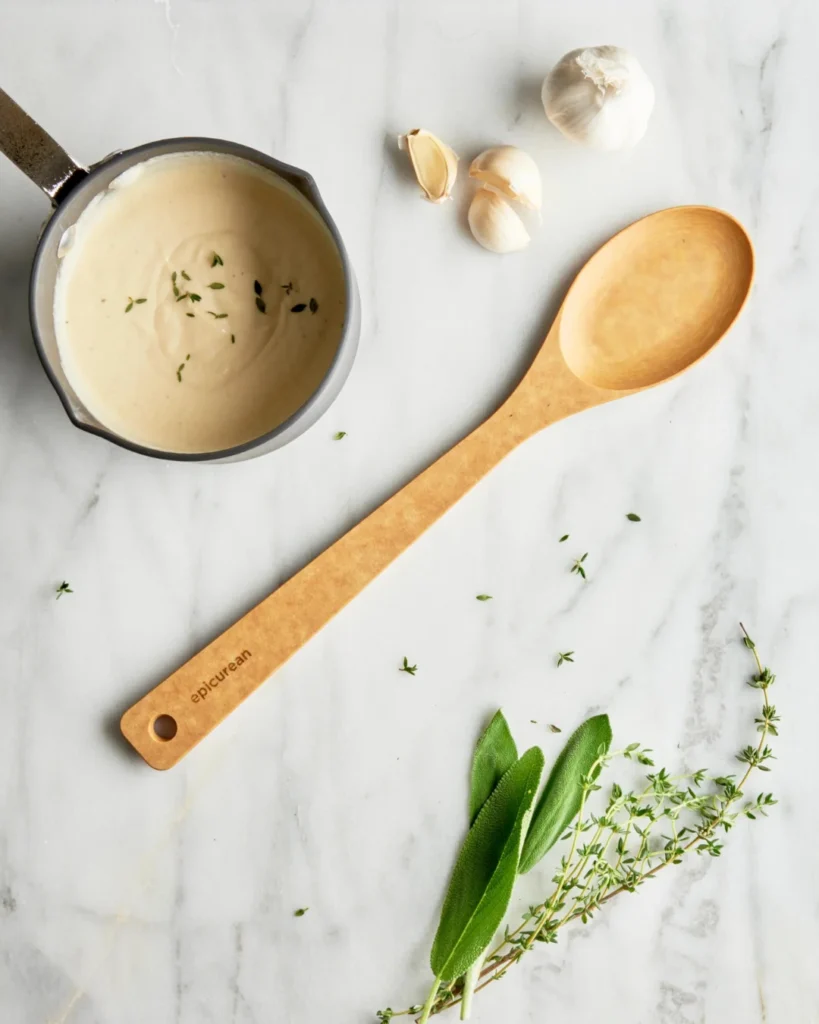
Our Top Picks: Safest Non-Toxic Cooking Utensil Brands
Plastic utensils can contain BPA and other harmful chemicals, which can leach into food, especially when cooking with high heat.
So, the easiest non-toxic living tip is to replace plastic spatulas, spoons, and tongs with those made from bamboo or wood. They are safe, and natural, and won’t scratch your cookware.
5. Choose Natural Dish Soaps and Cleaning Products
Our Top Picks: Natural & Non-Toxic Dish Soap Liquids, Tablets & Bars
Many conventional dish soaps and kitchen cleaners contain phosphates, synthetic fragrances, and triclosan, all of which can harm your health and the environment.
Instead, look for dish soaps and cleaning products labeled as phosphate-free, fragrance-free, or made from plant-based ingredients. Brands like Ecover and Seventh Generation offer great alternatives.
6. Replace Aluminum Foil with Silicone Baking Mats
Cooking with aluminum foil, especially with acidic foods, can cause aluminum to leach into your food. Long-term exposure to aluminum has been linked to neurodegenerative diseases like Alzheimer’s.
To kick start your chemical-free living, replace them with silicone baking mats instead of foil. They’re non-toxic, reusable, and work well for baking or roasting.
7. Switch to Organic or Cloth Dish Towels Instead of Paper Towels
Paper towels are often bleached and contain dioxins, which are harmful to the environment and your health. Plus, they contribute to unnecessary waste.
Use organic cotton towels or unpaper towels. They are reusable, more sustainable, and free from harmful chemicals.
8. Buy Organic Spices & Avoid Pre-Packaged Seasoning Mixes
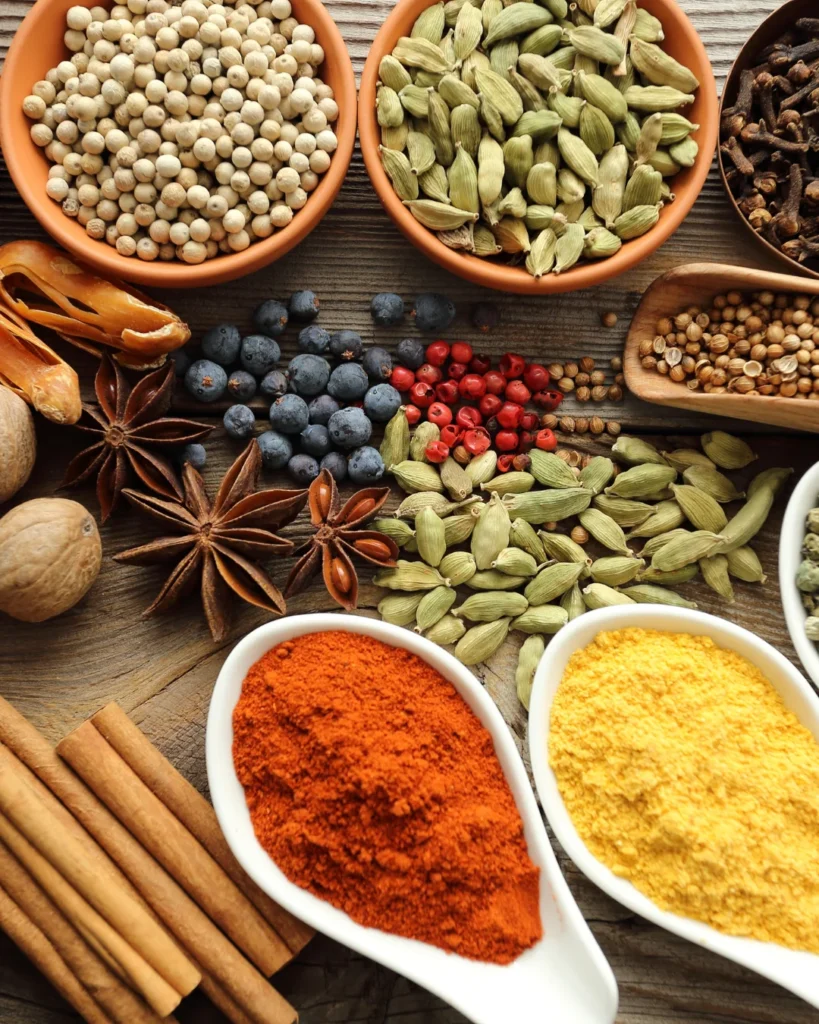
Pre-packaged spice mixes often contain MSG, artificial colors, and preservatives. These additives can cause allergic reactions, headaches, and other health issues.
Purchase organic, non-irradiated spices in bulk and mix your own seasoning blends. This ensures you’re avoiding unnecessary additives and toxins.
9. Filter Your Water
Our Top Picks: Best PFAS Water Filter Brands For Healthy Drinking Water
Tap water can contain chlorine, lead, fluoride, and other contaminants that are harmful when ingested regularly.
The easiest way to avoid that is to install a water filter system, whether it’s a reverse osmosis filter or a simpler option like AquaTru. Even a basic filter can reduce harmful chemicals and improve the taste of your water.
10. Opt for Glass or Stainless Steel Water Bottles Over Plastic
Our Top Picks: Best Reusable Water Bottles
Plastic water bottles can leach chemicals like BPA and BPS into your water, especially when exposed to heat or sunlight.
Switch to non-toxic alternatives like glass or stainless steel water bottles. These materials are safer, more durable, and won’t degrade over time like plastic.
Non-Toxic Living Tips For The Bathroom
The bathroom is where we clean, pamper, and take care of ourselves, but ironically, it’s also home to some of the most toxic products in our homes.
From shower gels to toothpaste, it’s easy to unknowingly expose ourselves to harmful chemicals on a daily basis.
The good news? You can easily transform your bathroom into a toxin-free sanctuary with just a few thoughtful swaps.
11. Upgrade Your Toothpaste
Our Top Picks: Best Zero-Waste Toothpaste Brands
Conventional toothpastes often contain triclosan, SLS, and fluoride, which can be harsh on your body over time. Triclosan, in particular, has been linked to antibiotic resistance and hormone disruption.
Go for organic personal care products like fluoride-free, SLS-free, or natural toothpaste made with ingredients like coconut oil, baking soda, and essential oils. Brands like Biöm or Huppy offer great non-toxic alternatives that still keep your teeth sparkly clean.
12. Swap Synthetic Soaps for Natural, Scent-Free Options
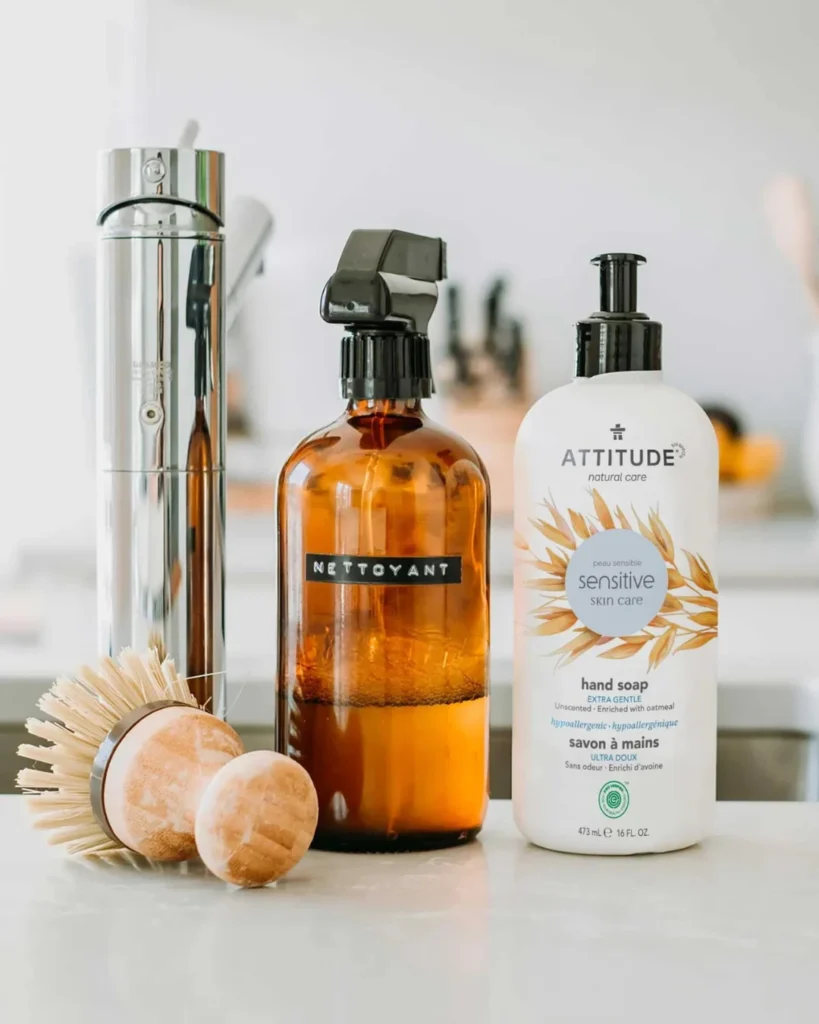
Our Top Picks: Best Non-Toxic & Antibacterial Hand Soap Brands Your Skin Can Trust
Many soaps are packed with synthetic fragrances, parabens, and SLS, which can dry out your skin and mess with your hormones.
The easiest way to avoid harmful chemicals is to opt for soaps made with organic oils, natural scents like lavender or eucalyptus, and no artificial dyes or perfumes.
You can also try castile soap, which is gentle on the skin and made from plant-based oils. I personally love using it because it’s super versatile—great for your skin and even some household cleaning!
13. Choose Non-Toxic Shampoo & Conditioner
Our Top Picks: Best Organic Drugstore Shampoo Brands
Hair products are often full of sulfates, parabens, and silicones that can irritate the scalp and strip your hair of its natural oils.
Sulfates, in particular, are the foaming agents that make you feel squeaky clean, but they can leave your hair dry and your scalp itchy.
Try a sulfate-free, paraben-free, and silicone-free shampoo and conditioner. Brands like Acure, Avalon, or Ethique offer non-toxic, eco-friendly hair care products that keep your locks looking healthy without the chemical overload.
14. Ditch Conventional Deodorants for Natural Alternatives
Our Top Picks: Best Natural Deodorant Brands For Women
Most antiperspirants contain aluminum, which blocks your sweat glands to reduce perspiration. While that sounds convenient, there’s concern that long-term aluminum exposure may be linked to breast cancer and Alzheimer’s disease.
Make the switch to a natural deodorant that uses ingredients like baking soda, arrowroot powder, and essential oils.
I’ll admit, it might take your body a few weeks to adjust (detoxing from chemical antiperspirants is real!), but once you do, natural deodorants like Schmidt’s or Native work just as well without the potential health risks.
15. Replace Plastic Razors with Stainless Steel Ones
Those cheap plastic razors you toss every month? They’re adding up in landfills and contributing to plastic waste. Plus, some disposable razors contain harmful chemicals in their moisture strips.
Invest in a stainless steel safety razor. It might sound old-school, but these razors are durable, offer a smoother shave, and use replaceable blades, making them way more eco-friendly. Plus, they look super chic sitting on your bathroom counter!
16. Opt for Organic Cotton Towels
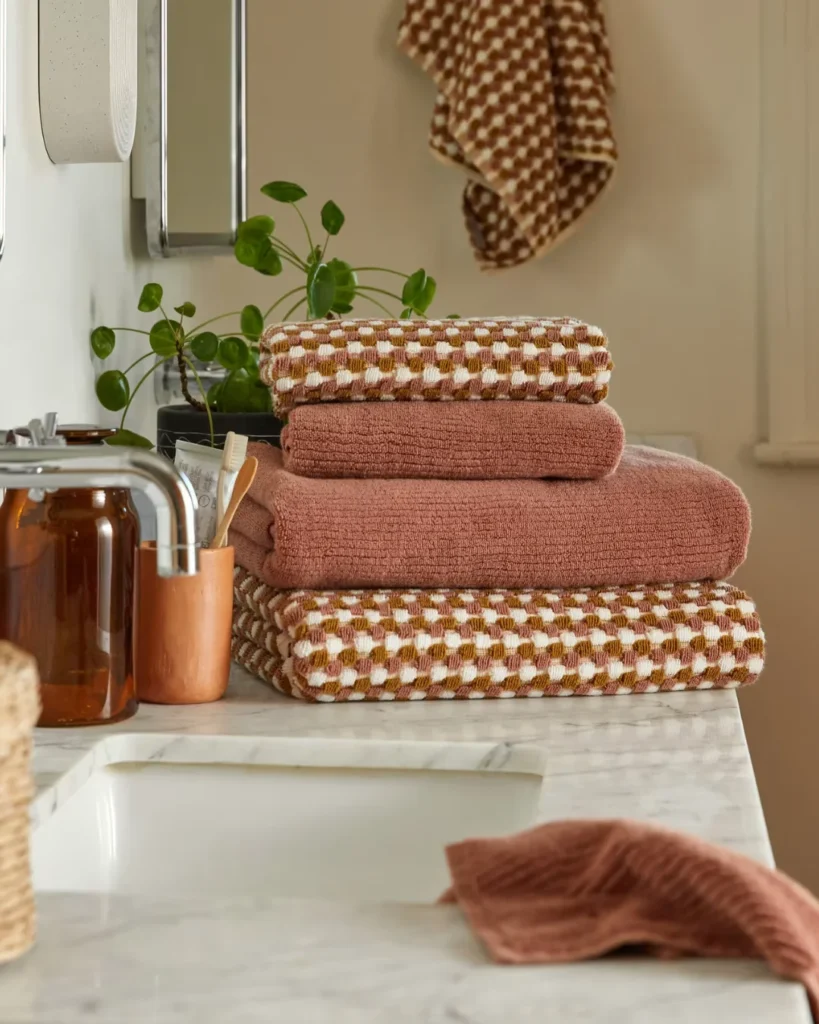
Our Top Picks: Best Organic & Eco-Friendly Towels
Standard towels are often treated with chemicals like formaldehyde to improve their absorbency and durability. Plus, conventional cotton is one of the most pesticide-intensive crops.
So why not upgrade to organic cotton towels or bamboo towels? Not only are they super soft and luxurious, but they’re also free from harmful chemicals. They’re a little indulgence that makes a big difference for your health and the planet.
17. Go Green with Your Toilet Paper
Our Top Picks: Best Non-Toxic & Eco-Friendly Toilet Paper Brands
Regular toilet paper is often bleached with chlorine, which can produce harmful by-products like dioxins. These chemicals can irritate your skin and cause environmental harm when they make their way into water systems.
Choose recycled toilet paper or toilet paper made from bamboo, which is sustainable and free from harsh chemicals. It’s a small change that makes a big impact, and trust me, your bum won’t notice the difference.
18. Use Non-Toxic Feminine Care Products
Conventional tampons and pads often contain pesticide-treated cotton and are sometimes bleached with chlorine. These products come into direct contact with sensitive areas, so it’s important to avoid harmful chemicals.
I’d highly encourage you to switch to organic cotton tampons, and pads, or consider reusable options like menstrual cups or period panties.
Brands like Cora or Lola offer great organic and toxin-free alternatives that are kinder to your body and the environment.
19. Trade Plastic Shower Curtains for Fabric
Our Top Picks: Safest Non-Toxic Shower Curtains | PVC-Free
Vinyl shower curtains can release PVC and phthalates, especially in the steamy environment of your bathroom. These chemicals are harmful to your health and contribute to indoor air pollution.
Go for a fabric shower curtain made from natural fibers like cotton or linen. They’re washable, last longer, and don’t emit toxic fumes. Plus, they add a touch of class to your bathroom decor.
20. Plant-Based Cleaning Supplies
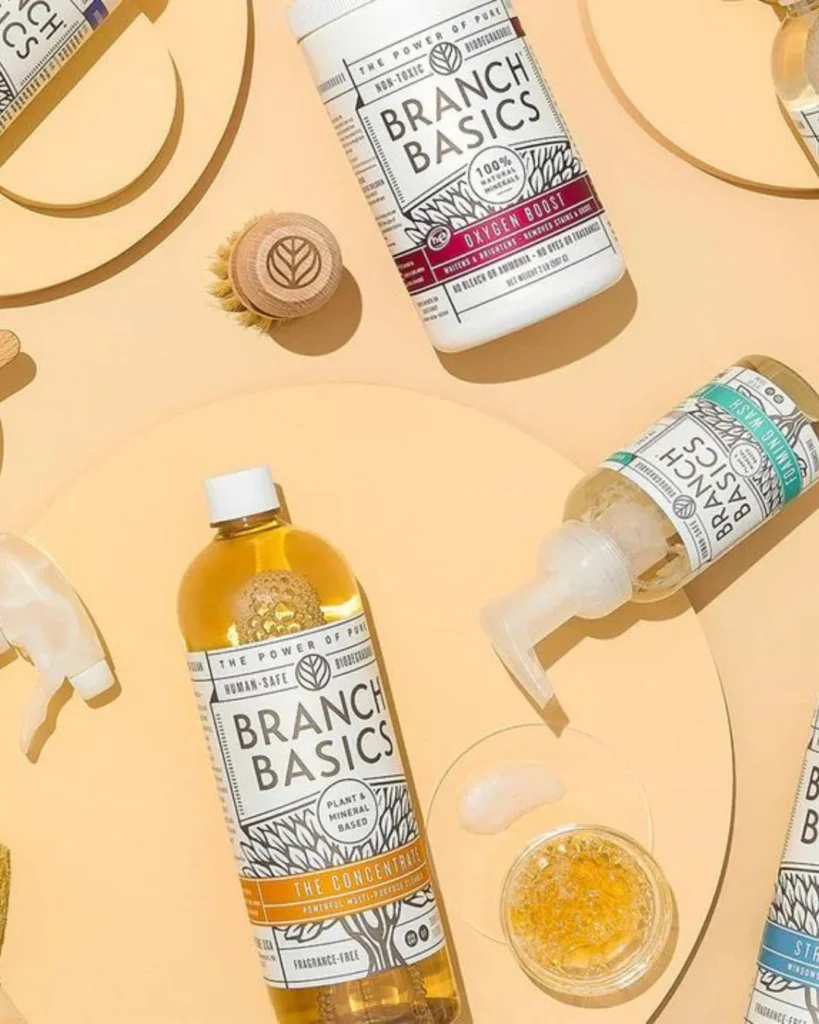
Our Top Picks: The Safest Eco-Friendly Cleaning Products For A Non-Toxic Hom
The harsh chemicals in bathroom cleaners (like bleach and ammonia) are not only irritating to your skin and lungs but can also contribute to indoor air pollution.
Swap Suggestion: Use non-toxic, plant-based cleaners for scrubbing the tub, sink, and toilet. Or go the DIY route and make your cleaner with just vinegar, baking soda, and a few drops of essential oils. It works wonders, and you won’t feel like you need a hazmat suit just to clean!
Non-Toxic Living Tips For The Bedroom
Your bedroom is where you go to recharge, rest, and get away from the chaos of the day, but it can also be a hidden source of toxins that affect your sleep and overall health.
Since we spend nearly a third of our lives in this space, it’s essential to make it as non-toxic as possible. With a few mindful swaps, you can turn your bedroom into a healthy, serene sanctuary that promotes better rest and overall well-being. Ready to make your sleep space work for you?
21. Choose Organic Bedding
Our Top Picks: Best Sustainable Bedding Brands For Eco-Friendly Sheets & Duvets
Conventional bedding is often made from cotton treated with pesticides and dyed with toxic chemicals. These toxins can linger on the fabric, exposing you to allergens and irritants while you sleep.
Start by opting for organic cotton, linen, or bamboo bedding that’s free from pesticides and harmful chemicals. Look for GOTS-certified (Global Organic Textile Standard) bedding to ensure it’s truly organic.
Trust me, there’s nothing quite like snuggling up in soft, breathable, and chemical-free sheets—your skin will thank you.
22. Swap Your Mattress for a Non-Toxic Option
Our Top Picks: Best Organic and Non-Toxic Mattresses
Most mattresses contain volatile organic compounds (VOCs), flame retardants, and other chemicals that off-gas and create indoor air pollution.
You spend hours in direct contact with your mattress, so those chemicals can easily enter your body through your skin or the air you breathe.
Look for a natural latex, organic cotton, or wool mattress that’s free from VOCs, flame retardants, and synthetic foams.
Brands like Avocado or Naturepedic offer non-toxic mattresses that are not only safer but also super comfortable. While they’re a bit pricier, think of it as an investment in your health (and better sleep!).
23. Use Non-Toxic Paint for Walls
Our Top Picks: Zero-VOC and Non-Toxic Paints for an Eco-Friendly Home
Standard paints contain VOCs, which release harmful chemicals into the air long after they’ve dried. These toxins can cause headaches, dizziness, and long-term respiratory issues.
If you’re planning a bedroom refresh, use low-VOC or VOC-free paints. Not only do they drastically reduce harmful fumes, but they also perform just as well as regular paint.
Benjamin Moore and ECOS Paints are great options if you want to add a splash of color to your space without compromising your air quality.
24. Invest in an Air Purifier
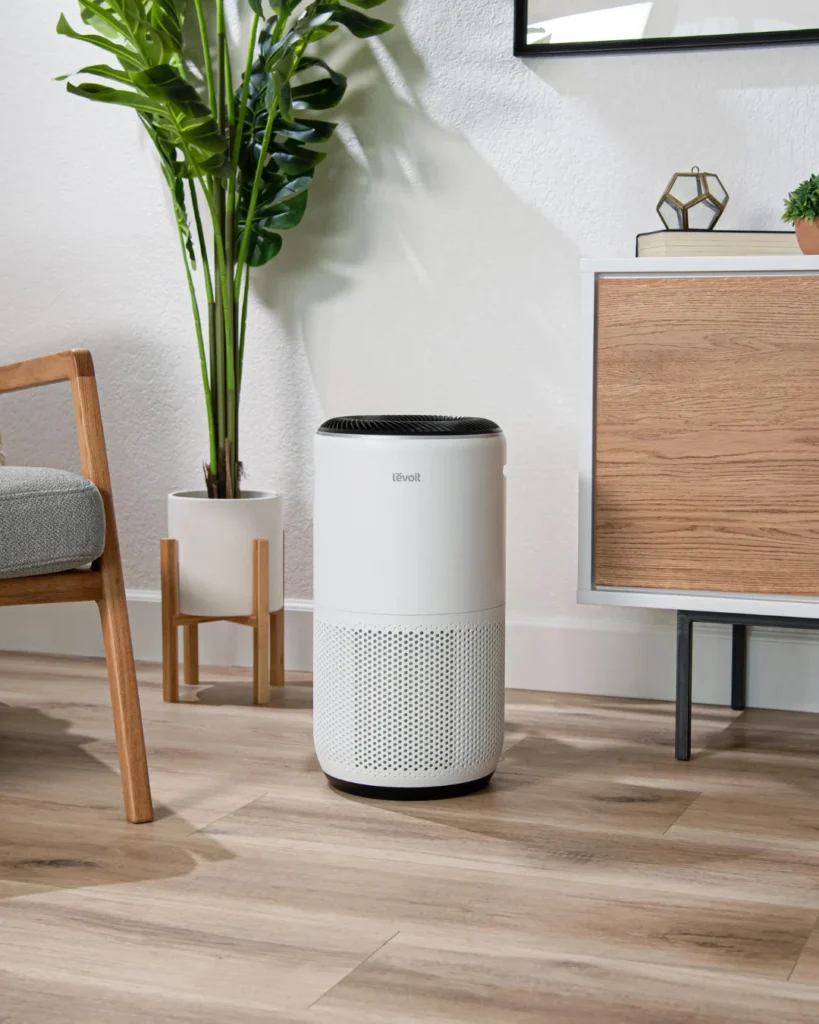
Our Top Picks: Best Home Air Purifiers in 2024 for Dust, Allergies, Mold, Smoke & More
Indoor air can be more polluted than outdoor air due to chemicals from furniture, dust mites, mold, and other toxins.
Since we spend so much time sleeping, it’s essential to keep the air as clean as possible and do our best to reduce indoor air pollution. Invest in a good-quality HEPA air purifier to remove dust, pollen, mold, and airborne toxins.
I’ve noticed a huge difference in how refreshed I feel waking up after running an air purifier overnight. Dyson or Alen purifiers are top picks and work wonders for improving bedroom air quality.
25. Switch to Natural Curtains or Blinds
Many curtains and blinds are made from synthetic materials treated with chemicals like formaldehyde to prevent wrinkling and stains. These chemicals can off-gas into your bedroom, affecting the air you breathe.
Choose natural fiber curtains made from materials like organic cotton, linen, or hemp. Not only do they look chic, but they also keep your bedroom toxin-free. As a bonus, they’re often much more durable than synthetic options.
26. Get Rid of Synthetic Carpets or Rugs
Our Top Picks: Best Places To Order Sustainable & Organic Rugs
Traditional carpets and rugs are often made from synthetic fibers and backed with materials containing VOCs, formaldehyde, and stain repellents. These can emit harmful fumes into your bedroom and accumulate dust and allergens.
So, make the switch to a natural fiber rug made from wool, jute, or organic cotton. These rugs are not only beautiful and cozy underfoot, but they also avoid the toxic off-gassing of synthetic carpets. And since they’re naturally durable, they last longer, making them a sustainable and eco-friendly option.
27. Use Natural Candles or Essential Oils
Our Top Picks: The Safest Non-Toxic Candles For A Healthy Home
Why it matters: Scented candles might set the mood, but many are made with paraffin wax (a byproduct of petroleum), which releases harmful chemicals like benzene and toluene when burned. Plus, synthetic fragrances can contain phthalates, which are endocrine disruptors.
Swap suggestion: Replace your conventional candles with beeswax or soy-based candles scented with essential oils. Or better yet, use an essential oil diffuser to create a calming atmosphere without the toxins. I love diffusing lavender or eucalyptus before bed—it turns my bedroom into a spa-like retreat!
28. Opt for Non-Toxic Furniture

Our Top Picks: Best Non-Toxic Furniture Brands For A Safe and Healthy Home
New furniture, especially items made from pressed wood or particleboard, can release formaldehyde and other chemicals into the air. These harmful substances are used in the glues and finishes and can be off-gas for years.
If you’re upgrading your bedroom furniture, look for pieces made from solid wood with non-toxic finishes or those labeled low-VOC. Thrifted or vintage furniture can also be a great alternative since any off-gassing has already occurred. Plus, it’s more sustainable!
29. Sleep Soundly with a Non-Toxic Pillow
Our Top Picks: Best Non-Toxic & Organic Pillows
Conventional pillows are often made from memory foam or polyester, both of which can contain flame retardants and VOCs.
Since your face is in direct contact with your pillow for hours each night, it’s important to make sure it’s not harboring hidden chemicals.
Invest in a pillow made from organic cotton, natural latex, or kapok fibers. These materials are naturally hypoallergenic, breathable, and free from harmful chemicals.
Trust me, after switching to an organic pillow, I noticed an immediate improvement in my sleep quality—and my peace of mind.
30. Go for a Toxin-Free Sleepwear Upgrade
Our Top Picks: Best Organic Cotton Pajamas For Women, Men & Kids
Just like your bedding, your pajamas can harbor pesticides and toxic dyes if they’re made from non-organic cotton or synthetic fibers. These chemicals can irritate your skin, especially during those eight hours you spend cocooned in them.
Treat yourself to some cozy, organic cotton or bamboo sleepwear. They’re super soft, breathable, and free from harmful chemicals. It’s a small swap that feels like a little self-care ritual every night!
Non-Toxic Living Tips For The Living Room
The living room is where we gather, relax, binge-watch our favorite shows, and entertain guests. It’s the heart of our homes, but it can also be a hub for hidden toxins.
From the furniture to the cleaning products you use, this space can harbor chemicals that affect your health. Fortunately, it’s easy to make this central room both stylish and safe with a few non-toxic swaps.
Let’s dive into some simple, practical changes you can make to detox your living room and turn it into a healthier, cleaner space.
31. Swap Out Toxic Furniture for Safer Options
Our Top Picks: Best Non-Toxic Couches and Sofas
Many couches, chairs, and other upholstered furniture are treated with flame retardants and made with synthetic materials that off-gas VOCs into your home. These chemicals can linger in the air, affecting your indoor air quality.
If you’re in the market for new furniture, look for pieces made from natural materials like organic cotton, wool, or sustainably sourced wood, and avoid those treated with flame retardants.
Brands like Medley and Savvy Rest specialize in non-toxic furniture options. Not ready for new furniture yet? Consider investing in organic slipcovers to reduce your exposure to these chemicals while protecting your current furniture.
32. Add Some Air-Purifying Plants
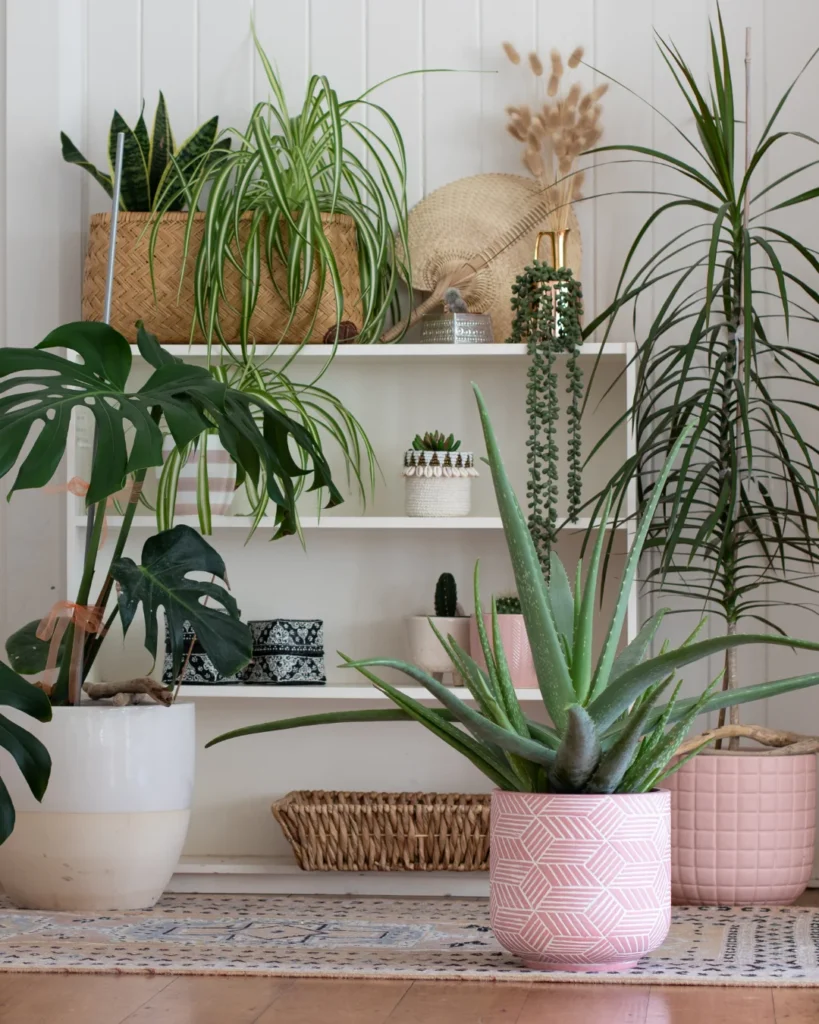
Our Top Picks: Eco-Friendly Air-Purifying Houseplants For Cleaner Air (NASA-approved!)
Indoor air can be full of pollutants like dust, VOCs, and allergens. Certain houseplants not only improve your home’s aesthetic but also act as natural air purifiers, filtering out toxins and boosting oxygen levels.
Bring in a few air-purifying plants like snake plants, spider plants, or peace lilies. These green friends are low-maintenance and can help reduce indoor toxins, making your living space feel fresher. Bonus: They’re also great for adding a natural touch to your decor!
33. Avoid Scented Candles and Air Fresheners
Our Top Picks: Non-Toxic Air Fresheners For Your Home & Car
Synthetic candles and air fresheners are often made with paraffin wax and phthalates, which release harmful chemicals into the air when burned.
These toxins can contribute to indoor air pollution and have been linked to headaches, respiratory issues, and hormone disruption.
Choose beeswax candles or candles made from soy wax with natural, essential oil-based fragrances. For a safer way to freshen up your living room, try an essential oil diffuser.
Not only do essential oils smell great, but many, like lavender and eucalyptus, also have calming or uplifting effects—perfect for creating a relaxing atmosphere.
34. Choose Organic Throw Pillows and Blankets
Our Top Picks: Best Places To Find Organic & Sustainable Throws & Blankets
Those soft, cozy throw pillows and blankets you snuggle up with might be made from synthetic fibers like polyester, which are treated with chemicals like flame retardants and stain repellents.
Upgrade your throws and pillows to those made from organic cotton, bamboo, or wool. They’re just as cozy but free from harmful chemicals, making your relaxation time healthier and more comfortable.
35. Remove Dust & Allergens with a HEPA Vacuum
Dust accumulates quickly in living rooms, bringing with it a host of allergens, dust mites, and potentially harmful particles like lead, pesticides, and flame retardants.
Regular vacuums might not capture all these microscopic pollutants, allowing them to recirculate in the air. Use a vacuum with a HEPA filter to effectively capture dust, allergens, and toxins from your floors, rugs, and furniture.
This reduces the amount of airborne particles, improving your indoor air quality. The HEPA filter traps tiny particles that other vacuums miss, making your living space cleaner and healthier.
36. Swap to Non-Toxic Electronics
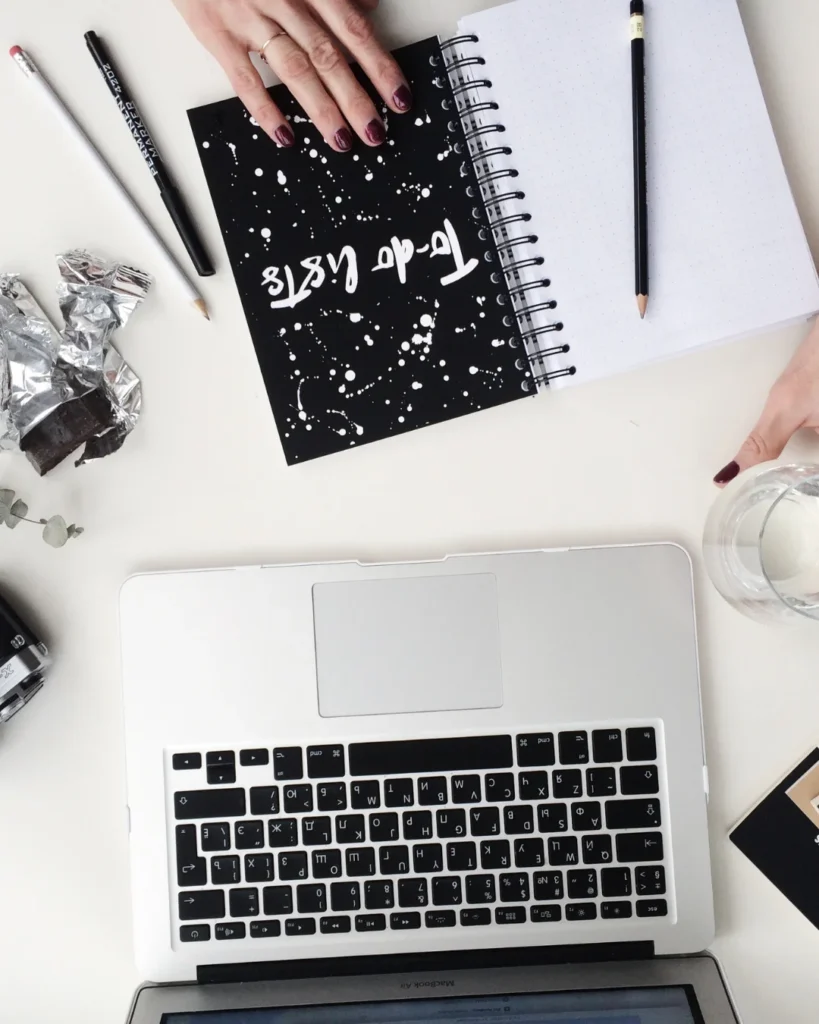
Our Top Picks: The Most Eco-Friendly Laptops
Many electronics contain flame retardants and heavy metals like lead and mercury, which can leach into your home’s environment over time, particularly as they degrade or overheat.
When it’s time to replace your electronics, opt for eco-friendly, Energy Star-certified devices. These not only use less energy, reducing your environmental footprint but are often made with fewer harmful chemicals. As a bonus, they’re usually more efficient, saving you money on your energy bills, too.
37. Embrace Natural Flooring
Our Top Picks: Best Non-Toxic Flooring Materials for a Healthier Home
Traditional flooring like vinyl and carpet can off-gas chemicals like formaldehyde, which is linked to respiratory problems and other health issues. These materials also trap dust and allergens.
If you’re considering new flooring, go for natural materials like hardwood, bamboo, or cork. These are not only more sustainable but also free from harmful chemicals. Plus, natural wood floors are timeless, adding warmth and style to your living room.
Non-Toxic Cleaning Products For The Laundry Room
If you’re like me, laundry might not be your favorite chore. But once you realize what’s hiding in conventional detergents and fabric softeners, you’ll want to make some quick swaps.
Here’s how to detox your laundry routine without breaking a sweat.
When I first learned about all the stuff in standard laundry detergents, I was floored. Synthetic fragrances? Check. Phosphates? Yep. Optical brighteners (whatever those are)? Absolutely.
These chemicals don’t just clean your clothes; they can irritate your skin, pollute waterways, and stick around on your fabrics long after wash day.
Look for plant-based, biodegradable laundry detergents and odor removers that keep it simple. Brands like Dropps, Seventh Generation, and Molly’s Suds offer great non-toxic options.
Or, if you’re feeling extra eco-friendly (and crafty), you can make your own laundry detergent using natural ingredients like baking soda, washing soda, and castile soap.
Fabric softeners are often packed with artificial fragrances and chemicals that coat your clothes in a layer of… let’s just say, not-so-great stuff. Dryer sheets? Same story.
Wool dryer balls are a fantastic alternative to conventional dryer sheets. They’re reusable, chemical-free, and even help reduce drying time, which means saving energy (yay, lower utility bills!).
If you still want that fresh scent, add a few drops of your favorite essential oil (think lavender or eucalyptus) directly to the dryer balls.
P.S. You can also check out our Best Eco-Friendly Laundry Tips!
Toxic-Free Home Solutions For The Baby Nursery & Kids’ Room
If there’s one place in your home where you really want to keep things safe and non-toxic, it’s your baby and kid spaces.
Babies and toddlers are notorious for putting everything in their mouths and crawling through who-knows-what on the floor.
The good news? Making some simple non-toxic living swaps can turn your baby’s space into a healthy haven, free from harmful chemicals.
38. Non-Toxic Baby Products
Our Top Picks: Must-Have Non-Toxic Baby Products For A Super Safe Baby Registry
Babies have extra-sensitive skin, and the last thing you want is for them to be in constant contact with irritating chemicals from their clothing and bedding.
Conventional baby clothes and crib sheets are often treated with flame retardants and dyed with synthetic colors that can be harsh on their skin.
Opt for organic cotton baby clothes, bedding, and swaddled. Organic cotton is grown without pesticides and is free from pesky flame retardants and chemical dyes.
Brands like Burt’s Bees Baby, Monica + Andy, and Finn + Emma are excellent options. Not only are they adorable (hello, cute prints!), but they also give you peace of mind knowing your little one isn’t exposed to unnecessary toxins while they snooze or play.
39. Organic Toys Instead Of Plastic
Our Top Picks: Best Natural Wooden Baby Toys For A Non-Toxic & Safe Nursery
When it comes to toys, steer clear of plastic as much as possible. Plastic toys can contain chemicals like BPA, phthalates, and PVC, which are not great for your baby (or the environment). And let’s be real—plastic toys always end up chewed on, dropped, and tossed around.
Choose toys made from sustainable materials like wood or natural rubber. Not only are they safer for your child, but they’re also more durable and often look way cuter scattered across the living room floor.
40. Opt for Chemical-Free Diapers and Wipes

Diapers might be the least glamorous part of parenthood (there’s no sugar-coating that), but they’re also a huge part of everyday life when you have a little one.
Conventional disposable diapers can contain fragrances, lotions, and even chemicals like chlorine bleach, which isn’t something you want against your baby’s skin 24/7.
Cloth diapers are a fantastic non-toxic and eco-friendly option. They’ve come a long way from the days of safety pins and complicated folds.
Modern cloth diapers, like those from GroVia and BumGenius, are easy to use, cute, and free from all those harmful chemicals. Plus, you’ll save a ton of money in the long run (think of all the coffee you can buy with those savings!).
If cloth diapers aren’t your jam, don’t stress. You can still reduce your eco-impact by choosing biodegradable, organic diapers from brands like Bambo Nature or Honest Company. These diapers break down more easily in landfills and are made without harsh chemicals.
As for wipes, opt for non-toxic baby wipes that are free from alcohol, synthetic fragrances, and other unnecessary chemicals.
Look for wipes made with simple ingredients like water, aloe, and chamomile. Or, if you want to take it a step further, you can DIY your baby wipes using soft cloths a simple solution of water, and a drop of baby-safe essential oils.
41. Non-Toxic Cleaning Cleaning And Sanitizing
Babies and toddlers are known for their love of exploring—touching, grabbing, and putting everything in their mouths.
Naturally, you want to keep their spaces clean, but many conventional cleaning products can leave behind harmful residues and fumes.
When it comes to cleaning baby toys, high chairs, and play areas, stick to natural cleaning solutions. Vinegar and baking soda are the dynamic duo of non-toxic cleaning.
Vinegar is a natural disinfectant and is effective at killing bacteria, while baking soda scrubs away dirt and grime without scratching surfaces.
For toys that can handle a little moisture, you can clean them by wiping them with a mixture of vinegar and water and then letting them air dry.
Got some grime that needs extra attention? A paste made from baking soda and water works wonders on tough spots.
And if you want to give everything a light fragrance (without synthetic chemicals), add a few drops of baby-safe essential oils like lavender or tea tree to your cleaning routine.
Non-Toxic Living Tips For Pets
We love our pets—they’re our companions, our cuddle buddies, and sometimes our workout partners (or at least they think they’re helping).
But just like us, they can be exposed to harmful chemicals through their toys, grooming products, and even food bowls.
The good news? It’s easy to make a few non-toxic living swaps that will help keep your pets healthy and safe without any hidden nasties.
42. Non-Toxic Pet Care Products
Our Top Picks: The Best Organic Pet Care Products For Happy Healthy Pets
Just like with human skincare products, a lot of pet shampoos and grooming products are loaded with synthetic fragrances, parabens, sulfates, and other chemicals that could irritate your pet’s skin.
And if your dog is anything like mine, bath time is already stressful enough without adding a rash or itchy skin to the mix.
Look for pet shampoos made with natural ingredients like aloe, oatmeal, and coconut oil. These are gentle on your pet’s skin and coat, while still getting the job done.
Brands like Earthbath and 4-Legger make excellent non-toxic pet shampoos that are free from synthetic fragrances and harsh chemicals. Your pet will be squeaky clean and smelling fresh—naturally!
When it comes to flea and tick treatments, conventional options often contain strong pesticides that can harm not only fleas but your pet’s health as well. Synthetic treatments can cause skin irritation, respiratory issues, or even long-term health problems for some pets.
Try natural flea and tick repellents that use essential oils like lavender, cedarwood, and lemon eucalyptus. These essential oils are known for their pest-repelling properties without the harmful side effects of synthetic treatments.
Wondercide offers great plant-based solutions, or you can DIY your own flea spray by mixing a few drops of essential oils with water and applying it to your pet’s coat (just be sure to dilute essential oils properly and do a patch test first).
43. Chemical-Free Pet Toys and Accessories
If you’ve ever caught your dog gnawing on a plastic toy for hours or your cat batting around a synthetic feather on a stick, you might have wondered what those toys are made of—and rightly so.
Many pet toys are made from low-quality plastic that can leach harmful chemicals like BPA, phthalates, and PVC. These can be especially concerning if your pet is a heavy chewer or likes to carry toys around in their mouth (which is, you know, every pet).
Look for toys made from natural materials like untreated wood, organic cotton, or natural rubber. Brands like West Paw and KONG have fantastic non-toxic options for both dogs and cats.
Natural rubber toys are durable, non-toxic, and great for keeping your pet entertained without the risks associated with plastic. Wooden toys, untreated and chemical-free, are excellent for pets who love to chew and shred (looking at you, puppies).
For cats, you can find toys made from wool or hemp—materials that are not only eco-friendly but also safe if your feline friend gets a little too enthusiastic during playtime.
44. Ditch Plastic Food and Water Bowls
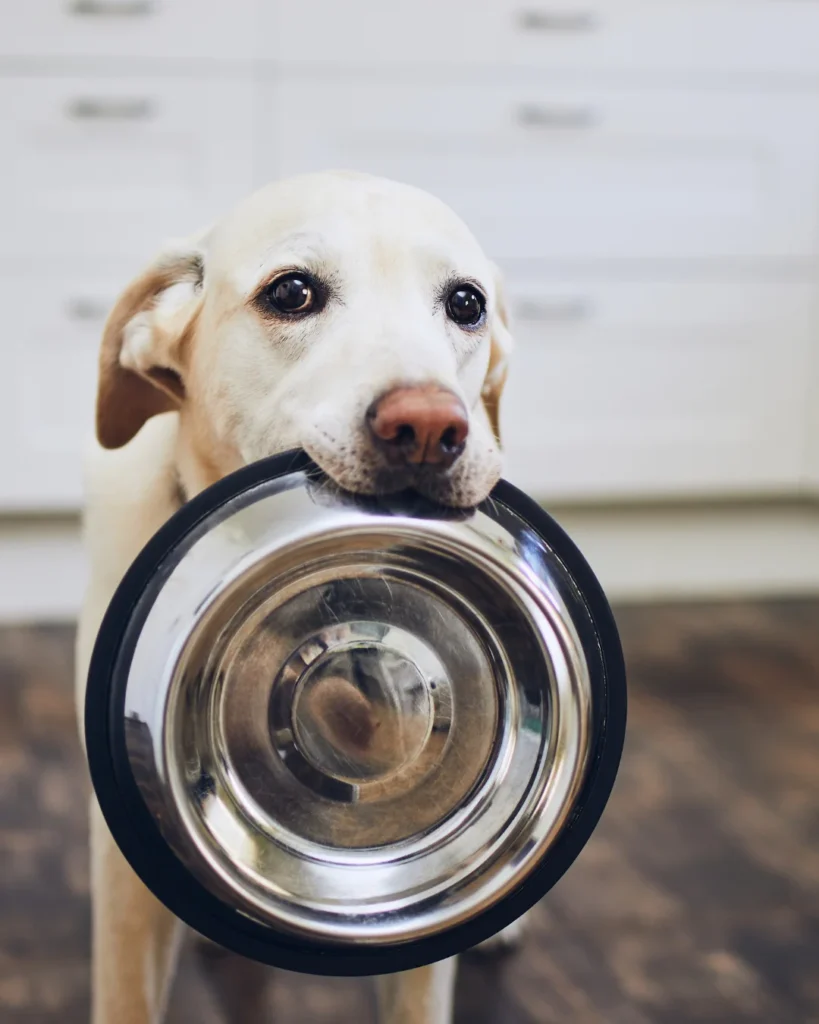
Many pet owners (myself included, at one point) default to using plastic bowls for food and water because they’re lightweight, easy to clean, and, let’s be real, they’re everywhere.
But plastic bowls can harbor bacteria in scratches, degrade over time, and even leach harmful chemicals like BPA into your pet’s food and water.
Switch to stainless steel or ceramic bowls for your pet’s food and water. Stainless steel is durable, non-porous, and easy to clean, which means no more worrying about bacteria build-up or chemicals leaching into your pet’s dinner. Plus, stainless steel bowls won’t absorb odors like plastic can, so your pet’s food will stay fresh.
Ceramic bowls are another great option, but make sure to choose ones that are lead-free and non-toxic. Look for bowls that are labeled as food-safe and made with high-quality, pet-friendly materials.
45. Bonus Tip: Non-Toxic Cleaning for Pet Spaces
Our pets love to sprawl out wherever they please, and that means they come into contact with every surface in the house—especially floors, couches, and bedding.
If you’re using chemical-laden cleaners on your floors or fabric sprays on your couch, your pets are absorbing those residues through their skin or inhaling the fumes (especially since they’re closer to the ground than we are).
Stick to natural cleaning solutions like vinegar, baking soda, or plant-based cleaners for cleaning up pet messes or washing their bedding.
Vinegar is a fantastic disinfectant that’s safe for pets while baking soda works wonders on pet odors without the need for synthetic fragrances.
For tough spots like accidents or spills, a simple combination of vinegar and water is usually all you need. And if you want a light, natural scent, you can add a drop or two of lavender essential oil—but remember, not all essential oils are safe for pets, so do your research and use them sparingly.
Tips For Transitioning To Non-Toxic Living Without Losing Your Mind
So, you’re ready to start your non-toxic living journey but not sure where to begin? First of all, kudos to you! Making this shift is one of the best things you can do for yourself, your family, and the planet.
But let’s be real—it can feel overwhelming at first, especially with all the info out there. That’s why I’m here to break it down for you with some simple, stress-free tips on how to transition without having to toss everything you own.
Start Small & Focus on Key Areas
The idea of going completely non-toxic in every area of your life might sound like climbing Mount Everest with no training.
But here’s the thing: You don’t have to do everything at once. In fact, it’s better to start small and focus on high-exposure areas first.
These are the categories where harmful chemicals tend to hide, but where simple swaps can make the biggest difference.
Prioritize These Swaps:
Personal Care Products: Your skin is your largest organ, and it absorbs whatever you put on it. This means products like shampoo, deodorant, lotion, and makeup can be major sources of chemical exposure. Start by replacing products that come into frequent contact with your skin with non-toxic options. For example, swap out deodorants with aluminum for a natural one, or choose organic, toxin-free makeup.
Cleaning Products: Conventional cleaning products often contain harsh chemicals like ammonia, bleach, and synthetic fragrances, which can linger in the air and on surfaces. Begin by switching out your all-purpose cleaner, bathroom spray, or laundry detergent for non-toxic alternatives (or make your own—more on that later!).
Cookware: We spend a lot of time thinking about what we eat, but not enough time considering what we cook it in. Non-stick pans are typically coated with chemicals like PFOA or PFAS, which can release harmful fumes when heated. A great first step is switching to stainless steel, cast iron, or ceramic cookware. You’ll avoid those nasty chemicals and bonus: these materials last longer, making them eco-friendly too!
Certifications & Labels to Look For In Non-Toxic Products
Let’s be honest: the aisles of stores are packed with products that look eco-friendly, but not all of them are as non-toxic as they claim. Greenwashing is real, folks.
That’s why it’s important to get savvy about labels and certifications so you can trust what you’re buying. When in doubt, look for third-party certifications that verify a product’s ingredients and environmental impact.
Here are some key certifications to look for:
- USDA Organic: When you see this on food or personal care products, it means the ingredients are grown without synthetic pesticides, fertilizers, or genetically modified organisms (GMOs).
- EWG Verified: The Environmental Working Group rates products based on their safety for human health. EWG Verified products are free from harmful chemicals and meet strict safety standards.
- Green Seal: Found on cleaning products, this certification ensures that the product is non-toxic, biodegradable, and safe for the environment.
- Fair Trade: This label ensures that the product was produced ethically, with fair wages and sustainable practices. You’ll often find this on items like coffee, chocolate, and clothing.
- Leaping Bunny: This certification ensures that a product is cruelty-free, meaning it was not tested on animals. It’s a must-look-for on personal care and household products.
Apps & Tools to Help Identify Non-Toxic Living Products
Shopping non-toxic doesn’t have to involve hours of research. There are some amazing apps and tools that make it easy to find safe products with just a few taps on your phone.
- Think Dirty: This app lets you scan the barcode of personal care and household products to see their safety rating. It breaks down each ingredient and tells you if it’s harmful, so you can make informed decisions right in the store.
- EWG’s Skin Deep: Similar to Think Dirty, this database rates beauty and personal care products based on their ingredients’ toxicity. It’s a fantastic resource when you’re looking to swap out your makeup, skincare, or sunscreen.
- GoodGuide: This app provides ratings on a wide range of products, including food, household cleaners, and personal care items. It takes into account health, environment, and social responsibility to help you shop smarter.
DIY Non-Toxic Living Products & Solutions
One of the easiest (and cheapest) ways to go non-toxic is to make your own cleaning and beauty products.
Don’t worry—this doesn’t require a degree in chemistry or hours of your time. With a few simple ingredients, you can whip up everything from an all-purpose cleaner to a soothing face mask.
Plus, DIY products are completely customizable, so you know exactly what’s going into them.
DIY Cleaning Products
- All-Purpose Cleaner: Mix one part white vinegar with one part water, add a few drops of your favorite essential oil (like lavender or lemon), and voilà—you’ve got a safe, effective cleaner for countertops, floors, and more.
- Glass Cleaner: For streak-free shine, combine 1 cup of water, 1 cup of rubbing alcohol, and 1 tablespoon of white vinegar in a spray bottle. Your windows and mirrors will thank you.
- Carpet Deodorizer: Sprinkle baking soda over your carpets, let it sit for 15 minutes, then vacuum. The baking soda absorbs odors, leaving your carpets fresh without any need for artificial fragrances.
DIY Beauty Products
- Face Mask: Mix together 2 tablespoons of honey and 1 tablespoon of plain yogurt for a soothing, hydrating mask. Honey is naturally antibacterial, while yogurt gently exfoliates.
- Body Scrub: Combine 1/2 cup of sugar or sea salt with 1/4 cup of coconut oil for a simple, effective scrub that will leave your skin smooth and moisturized.
- Dry Shampoo: Blend equal parts cornstarch and cocoa powder (for brunettes) or just cornstarch (for blondes) and apply to roots with a makeup brush. It absorbs oil and adds volume without any harsh chemicals.
You can check out these Homemade Oven Cleaner Recipes!
This was your full guide to non-toxic living for beginners!
These were my tried and true non-toxic living tips for beginners who strive for a healthy home environment. By reducing your exposure to toxins, you’re not just doing your body a favor — you’re helping the planet too.
Every non-toxic product you choose over a conventional one means fewer chemicals polluting our air, water, and soil. Plus, non-toxic products often come in eco-friendly packaging, further reducing your waste footprint.
Remember, chemical-free living isn’t about striving for 100% perfection. It’s about making conscious choices that reduce your exposure to harmful chemicals while supporting a healthier environment. Even small swaps can have a big impact over time.
So, whether you’re just starting or already on your way, remember that each change you make is a win for your health and the planet.
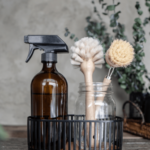 Snag Your Free DIY Non-Toxic Cleaning Recipe Ebook!
Snag Your Free DIY Non-Toxic Cleaning Recipe Ebook! 